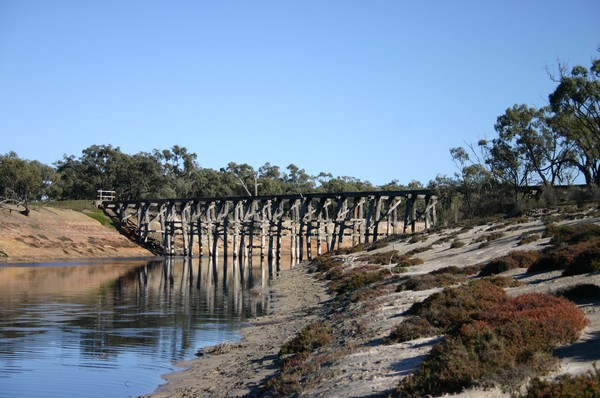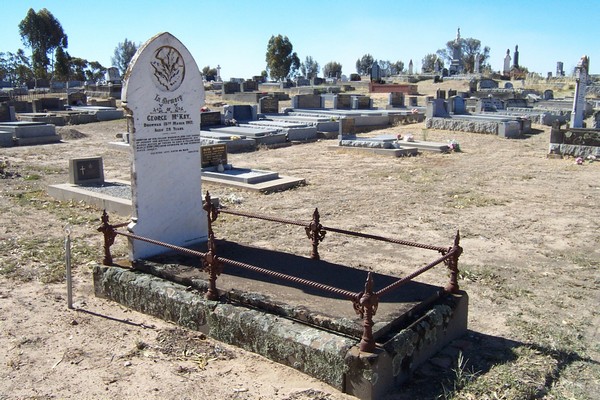Today is the 110th anniversary of a tragic accident during the construction of the railway bridge over the Wimmera River near Jeparit in 1912, which resulted in the death of two men and a moving act of selfless heroism.
We are marking the occasion with an updated article that was originally published on the 105th anniversary in 2017. The construction of railways at this time was very labour intensive and attracted many itinerant workers to the district who would then move on to the next project when one was completed.
Amongst those attracted to Jeparit by the work available on the railway line being built to Lorquon were James Dowling and George McKay, both of whom were unmarried and new to the district.
Dowling had commenced work four weeks earlier and was a Wimmera local, with his parents living at Goroke, and he also had other relatives working on this railway, whilst McKay was from Scotland and had only taken up this job the morning before.
Despite their short time in the community, both men were well respected by their colleagues.

Above - The railway bridge near Jeparit, looking downstream towards Lake Hindmarsh.
On the morning of the accident, both men were sent across the river to tie off a rope on the other side, but their barge capsized throwing them into the water. McKay, a strong swimmer, made it to the river bank, but upon seeing Dowling in trouble, he did not hesitate to return to the water to attempt a rescue.
McKay caught his co-worker once, but in his panic, Dowling broke free only to have his rescuer try once more, but in the struggle to catch him again, Dowling gripped McKay so strongly that it prevented him from getting them back to the shore.
As the horrified workers looked on, both men disappeared below the water and did not resurface.
The account of this act of heroism was widely published, appearing in many newspapers around Australia during the following week.
The unselfish actions of McKay so touched his co-workers and the community of Jeparit that they buried him in a prominent location in the local cemetery and then raised the money to pay for a large gravestone to mark his final resting place. Dowling was buried elsewhere.

Above - George McKay’s grave occupies a prominent place in the Jeparit cemetery.
No further work was carried out on the bridge on the day of the accident, but construction continued after that, and the line was opened to Lorquon by the end of the year and extended to Yanac four years later.
The entire railway line between Jeparit and Yanac was closed in December 1986.
Although now no longer used for its original purpose, the bridge has recently been the focus of some debate on how it might be incorporated into the Wimmera River Discovery Trail project. The options put forward include reinstatement of the deck and suitable upgrades to allow pedestrians to use it to cross the river safely or for construction of a new bridge adjacent to the site, allowing those using the trail to view the existing structure.
No matter what option is selected, it is hoped that it can be a suitable ongoing memorial to the unselfish bravery shown by George McKay 110 years ago.
The following article appeared in the Horsham Times on Tuesday 19 March 1912, and was sourced from Trove.
Two Men Drowned.
A JEPARIT TRAGEDY.
A shocking accident (writes the Jeparit Leader) occurred at the railway construction works, some two miles from the township, on Friday morning, whereby two strong young men lost their lives.
George McKay and James Dowling were told off to cross the river on a barge, to make secure a guy rope that stretched across from a tree to the derrick where pile driving operations: are conducted. The barge is built to carry four persons.
No one saw really how the accident happened, but it is surmised that on reaching the opposite bank the men neglected to make fast their barge before commencing the work of tightening the rope, and in some manner they were capsized into the stream.
The first warning received by the workmen on the bridge was a cry for help from Dowling, who was floundering about in deep water. A man named Henderson took in the situation at a glance, and he immediately cried out to McKay, who was on the bank halfway out of the water, to save Dowling from drowning.
Unhesitatingly McKay turned round and went straight to his mate’s assistance. He was observed to come once into holds with Dowling, and then free himself, only to immediately renew his efforts.
A horrifying death struggle then presented itself to the view of the spectators who were watching events with bated breath from the works opposite.
Dowling was obviously drowning, and in his death struggles gripped hold of his would-be rescuer so tenaciously that he bore McKay with him to the bed of the river.
Neither rose to the surface again.
The whole affair happened quicker than the time it takes to record it, even before a hand could be raised by anyone to render assistance.
The suddenness of the tragic happening was appalling. Even when it was discovered that Dowling was in a serious predicament, no great fears were felt for his position, as they all knew McKay to be a strong swimmer, and believed he would not have very much difficulty in pulling his comrade to safety.
Undoubtedly, McKay gave his life in the attempt to save Dowling, and all who read this account must feel a glow of pride for the heroism displayed.
According to eye-witnesses he must have realised the danger attending his efforts to save the drowning man, having once broken free from his mate’s clutches, but undauntingly renewed his efforts, knowing without doubt that a drowning man’s grasp was a fearful thing to contend against.
The accident occurred a little after nine o’clock, and all haste was trade to recover the bodies.
Constable Morrison was apprised of the event, and, equipped with grappling irons, he hastened to the spot.
McKay’s body was recovered first, at about a quarter to ten o’clock; Dowling’s was raised about half-past ten.
The bodies were only a few feet apart, resting in about 20 feet of water. At the spot the river bank slopes acutely, and in mid stream the river is about 21 feet deep.
Dr. Gawne was in attendance, but a brief examination showed that life was extinct. The bodies were conveyed to the Hindmarsh Hotel to await a magisterial inquiry.
No further work was done on the bridge on Friday after the accident.
Both deceased men were unmarried and strangers to the district, but those who knew them spoke well of them, Mr. Ashton describing them as honest, hard-working fellows. Dowling, whose parents live at Goroke, boarded with Miss Smith, of Broadway.
He had been employed on the works from the 15th of last month and always gave satisfaction with his work. He has relatives working on the construction works towards Lorquon, and the shock they received on hearing the sad news can well he imagined.
The man McKay was a seaman. He recently arrived in this country from Scotland, and was formerly employed on the railway construction works on the Maroona-Gheringhap route.
He commenced work the morning before the tragedy. He was 29 years of age, known to be a powerful swimmer, and was quiet and unassuming in character.
Only that morning he had exhibited to a mate a pair of woollen socks which he had just received from his sister in Scotland.
The news of the accident was received with consternation in the township, and the deepest sympathy is expressed for the bereaved families in their sad loss.
Mr. Livingston, J.P., conducted a magisterial inquiry.
The evidence elicited was in accordance with the particulars given in the above account of the accident. The following verdict was recorded - "That deceased James Dowling and George McKay came by their death from accidental drowning, but I think that a boat should be provided and kept in constant readiness in case of accidents of this description.’
|






